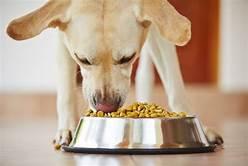It’s been said over and over, the dog is a man’s best friend. That’s why we have this strong affiliation with dogs, we give high-quality care it deserves, dog food and pet dog treats included.
Just like us humans, dogs love food treats, too. However, just like us, dogs get too many calories from pet treats.
According to veterinarians, pet treats should only be 10% of the dog’s daily calories. If you’re not sure of the number of calories you’re giving to your pet, ask your vet. He or she will recommend a nutrition plan based on the treats your dog likes, its weight, and how active it is.
Giving dog treats is one way to bond with our pets. However, commercially available treats may contain ingredients we are not familiar with even though it’s labeled as “natural”. That’s the reason why we prefer to make dog treats using a food dehydrator.
Table of Contents
Benefits Of Home-made Dried Dog Treats
We already discussed before that food dehydration, as an ancient food dehydration technique, removes moisture that allows microorganisms to thrive thus causing food spoilage. Dried foods extend their shelf life and at the same time, retains its nutrients despite being dry.
Also, the cost of making your own pet dog treats is much less than buying them from the store. Once you have covered the cost of your food dehydrator, you will be saving money over time. And the cost of electricity to power your dehydrator may be set off if you have a cost-efficient unit.
Another benefit of making your own pet treats is the peace of mind that you get knowing where the ingredients come from.
Convenience is probably the ultimate benefit because all you have to do is slice the ingredients, pop them into the dehydrator, and wait for the treats to dry. Some food dehydrators come with a controllable thermostat and timer that allows set and forget the drying process until the timer starts ringing. Once drying is done, cleaning the trays could also be easy as the trays require little washing.
What Dog Treats Should Be
Ideally, pet treats for your pooch should be packed with protein and with no additives like artificial flavors and added sodium or sugars. Although some commercially available dog food and pet treats are labeled as “natural”, you may find some ingredients that don’t sound natural at all upon inspection.
Although food preservatives are necessary to prolong the food’s shelf life, dog treats should have no artificial preservatives or coloring. The use of chemical food preservatives has raised some health concerns for humans and pets as well.
Dog treats should come from safe identifiable meat products. That means we should know what kind of meat or what meat by-products are used. “Meat meal” may consist of organs and bones but it’s difficult to assess the quality because these products are not regulated as compared to other meats.
Beware of dog treats that are rich in corn, wheat, or soy as these grains are used as fillers. Look for nutrient-dense carbohydrates like sweet potatoes. Also, cut down artificial sweeteners like corn syrup or sugar as dogs are also prone to obesity.
Most of all, dog treats should be canine-approved. If your dog loves the treats you’re giving, then you’re probably doing a great job and have mastered how to use a food dehydrator.
Finding The Right Dog Treats For Your Pet

- Pay attention to your dog’s preference. Start with safe, healthy ingredients until you get down to your pet’s personal favorite. Some dogs prefer the soft, chewy texture while others prefer the crunchy bites. Your dog may prefer beef, chicken, or fish as the main protein or flavor. As long as your pet doesn’t have allergies with the ingredients, experiment with the treats and see which ones your dog loves best.
- Look for allergic reactions. Did you know that a study found out that beef is the most common dog allergen? Protein and dairy are the most common source of food allergy in dogs. If your dog shows signs of allergy like dry skin or upset stomach, check your protein source first. Limit or eliminate it first until you can narrow down the ingredients that cause the hypersensitivities.
- Use dog treats in moderation. It should only consist of 10% of the dog’s daily diet.
- Marketing labels like “premium” or “gourmet” may not mean anything. Instead, look for meaningful labels like “natural” or “organic” and double-check for artificial ingredients posing as natural.
Keep in Mind the Dog’s Size
Take consideration of your dog’s size when making dehydrated dog treats. Of course, small dogs have small mouths and a tiny set of teeth which may require small, bite-size, chewy treats. Big dogs, on the other hand, can handle bigger bite-sized, crunchy treats.
Dog Treats Recipes
Sweet Potato Dog Chews
- Scrub sweet potatoes or yams. No need to peel them.
- Slice into 1/8″ to 1/4″ pieces.
- Place them on your dehydrator trays and dry for 3 to 12 hours.
Dried sweet potatoes are done when you can twist and flex them without breaking apart. If you prefer a crunchy chew, make thin slices and dry until they become crispy when broken.
Chicken Jerky For Dogs
- Use boneless, skinless chicken breasts and trim off any fat.
- Slice them into 1/8″ to 1/4″ thick pieces.
- Place them on your dehydrator trays and dry for 3 to 12 hours.
- To check if it’s done, take a slice and cut it in half. It should be dry in the middle without any signs of moisture and its color should appear even.
Liver Treats
- Use any meat you like, not just chicken or beef. Slice them into 1/8″ to 1/4″ thick and place them on dehydrator trays.
- Dry them for 3 to 12 hours.
- To check if it’s done, take a slice and cut it in half. It should appear dry and moisture-free and its color should be even all throughout.
Do not limit yourself with liver, try experimenting with other organ meats you may find in the market. Ask your butcher for suggestions.
Dried Green Beans
- You may use plain green beans or season them with powdered meaty dog treats before drying.
- Cut the ends of each green beans and lay them out on dehydrator trays.
- Dry them for 3 to 6 hours until they become crispy.
Banana Dog Treats
- Choose firm bananas and slice them into 1/8″ to 1/4″ pieces.
- Toss them into melted peanut butter or coconut oil before placing them on the dehydrator trays.
- Dry for 3 to 12 hours.
Canned Food Treats
There are dogs who are too sensitive that they have diet restrictions thus their only source of food is the ones in the can. Actually, this is much easier to do.
Spoon 1/4 teaspoon of dog food on to dehydrator trays and dry for 6 to 8 hours. Or if you have a piping bag or jerky gun (Amazon link), pipe out some shapes on the tray.
Can dog treats go bad?
Yes, of course. Although they have a longer shelf life than human food, dog treats also have an expiration date. Most pet treats last longer than 2 to 3 weeks. It can also lose nutritional value over time.
Final Thoughts
It is not only human food that can be dried using a food dehydrator. We could also make home-made dried pet dog treats at home. Whether your pooch prefers chewy, soft, tough, or crunchy treats, you can find the best pet treat for them. Go ahead and experiment. Your dog might even watch you prepare.

